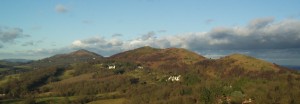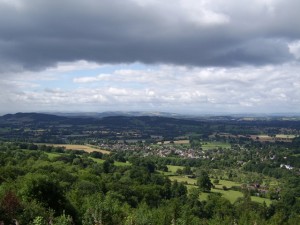
The Malvern Hills ridgeline
The rocks of the Malvern Hills consist of igneous and metamorphic rocks collectively referred to as the Malverns Complex. They formed about 680 million years ago. Travel back in time to the Precambrian and the position and shape of the continents was completely different from today. This area was located some 60° south of the equator on the northern edge of an ancient supercontinent called Gondwana. The collision of two tectonic plates at the edge of this landmass resulted in one of the plates sliding under the other along a line known as a subduction zone. The intense heat and pressure caused by the movement of the slowly descending plate led to the formation of most of the igneous and metamorphic rocks seen on the Malvern Hills today.

Diorite
The dominant igneous rocks on the Malvern Hills are dark green-speckled diorite; made up mainly of feldspar and the ferro-magnesian minerals biotite and hornblende, and plutonic pink granite; its components of quartz and feldspar giving the rock a pink colour. Later episodes of plate tectonic activity led to further bodies of magma forming, which were forced into cracks in the pre-existing Malvern rock. This magma then cooled and solidified, forming bodies (sills, dykes and veins) of dark-coloured igneous rocks called microdiorite and pink-coloured igneous rocks called pegmatite. In addition, the Malverns Complex suite of rocks include minor amounts of amphibolite (a dark green ultrabasic rock consisting entirely of hornblende) and the metamorphic rocks gneiss and schist. Gneiss is formed by extreme heat and pressure acting on pre-existing rocks. The minerals within gneiss are arranged in light and dark bands. Schist readily splits into flakes or slabs often with the mineral mica present.
Also found in the Malverns Hills are some ancient volcanic rocks known as the Warren House Formation. They comprise a suite of spilitic basalts (lava), rhyolites (lava) and ignimbrites (pyroclastic rocks). The eruption of these lavas has been dated at 566 million years ago, 100 million years after the formation of the Malverns Complex. The presence of ‘pyroclastic’ rocks (meaning ‘fire’ and ‘broken’) shows that these volcanic eruptions were extremely violent. These rocks can be seen on Tinker’s Hill, Broad Down and on Hangman’s Hill.

The ridge and vale topography to the west of the Malvern Hills
The younger Silurian rocks (438 – 416 million years ago) lie immediately to the west of the Malvern Hill ridgeline. This suite of varying sedimentray rocks all formed in a
marine environment. At the beginning of Silurian times sea levels rose with the melting of ice at the end of the Ordovician Ice Age. During early Silurian times the Malverns formed the eastern shoreline of the Welsh Sea. Some of the material eroded from the landmass to the east (the Midlands Platform) was transported west by streams to the nearby shore. This sediment over millions of years turned into siltstones, sandstones, breccias and conglomerates. Later during Silurian, limestones, mudstones and siltstones were deposited in the Silurian sea. Many of these rocks contain fossils.
Explore the Geology and Landscape around the Malvern Hills GeoCentre
- The Geopark Way long distance walking trail passes the Malvern Hills GeoCentre. Section 10 of the trail guide North Malvern to Colwall Stone. Trail guide available from the Malvern Hills GeoCentre.
- Section 10 of the Geopark Way also available as an App. The FREE app has a map of the section overlain on an interactive geology map. Using GPS you get your position and a feed of data about the geology and other information as you walk. Other information’ includes photos of the walk with directional guidance, 3D cross-sections, and interpretations of past environments. Created by BrooksDesigns
- Other geology and landscape trails in the area are:
- ‘The Wyche and Purlieu‘, ‘Malvern Hills 1‘, ‘Malvern Hills 2‘, ‘Great Malvern‘ – available from Malvern Hills GeoCentre
- Malvern Hills ‘Champions’ trail and booklet – geology of the Malvern Hills and trail guide – available from Malvern Hills GeoCentre
- Mathon and the Malvern Hills – Geopark Way circular – free download
Explore the bedrock and superficial geology of the area around the Malvern Hills GeoCentre on the British Geological Surveys ‘Geology of Britain Viewer’ – click here to be directed to their webpage



